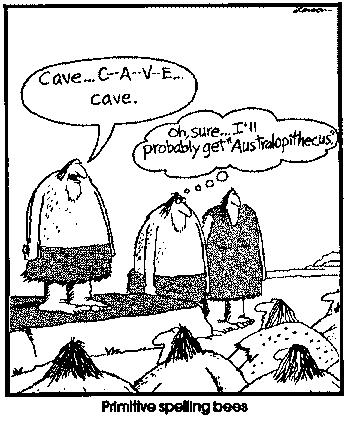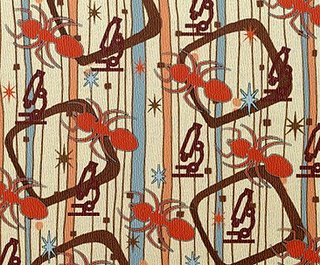Tuesday, October 31, 2006
Monday, October 30, 2006
Updated Ant Quiz
Along with my misspelling of a major ant subfamily, I also apparently had some errors in my online ant quiz. When I went through to correct them I decided to add a few more questions and include the genera in the message you get when you choose correctly. If anyone else notices any problems, please let me know!
Posted by
Kari T. Ryder Wilkie
at
6:54 PM
2
comments
![]()
How to spell Myrmicinae

So I got an email the other day from James Trager pointing out that I had misspelled Myrmicinae all over my webpage. Yikes! He's right. I've been spelling it Myrmecinae and it is supposed to be Myrmicinae. From his email:"There are two related but different roots from Greek that have entered the language of ant taxonomy, namely "myrm-" "myrmec-". The name Myrmica and its derivative Myrmicinae, rather confusingly, are based on the first root plus the suffix "-ic", so people make the error in spelling the subfamily Myrmicinae quite often."
I did a quick search on google and found out that it is really true. There were over 1100 pages that used the wrong spelling, including Wikipedia and several articles published on scientific journal webpages (although I don't know if they were duplicated in print versions). Anyway, I think I have now changed everything on my research webpage to the correct spelling. Thanks James!
Posted by
Kari T. Ryder Wilkie
at
6:31 PM
0
comments
![]()
Sunday, October 29, 2006
More Wasmannia

After going over all my Wasmannia again, I have come to the following conclusions:
- All the specimens I originally labeled as sigmoidea are actually cf lutzi.
- All the specimens I originally labeled as lutzi are actually rochai.
- And all the queens I originally labeled as auropunctata are cf lutzi. These queens are all quite large with head width around 1.1 mm and thorax length around 1.75 mm.
- Interestingly, all the rochai specimens were collected from the canopy and all of the cf lutzi specimens were collected from the ground except for 2 of the queens.
Posted by
Kari T. Ryder Wilkie
at
7:07 PM
0
comments
![]()
Tuesday, October 24, 2006
Wasmannia Update
"...the stuff I labeled lutzi could be called cf. lutzi. I've only seen one collection of lutzi, the types from Sao Paulo. So I don't know what variation is like. But your specimens are almost exactly in between lutzi and auropunctata. The workers are nearly identical to auropunctata except with petiole shape of lutzi. The queen is bigger than auropunctata, but the shape of the head and frontal carinae are like auropunctata instead of lutzi. I bet it is an undescribed species."
And as I recall my issue with (what I thought was) sigmoidea was that they seemed a lot like auropunctata except for that petiole, so actually that seems like a reasonable mistake for me to have made. The critical couplet is the one which involves the antennal scrobes being narrow or broad. If this key ever gets published, I would caution folks to be especially careful on that couplet.
The auropunctata (workers), iheringi, and scrobifera were all correct and pretty easy to ID. I'm guessing that all my sigmoidea are all cf. lutzi, but I will have to look at them all again before saying that. And I will definitely have to recheck my lutzi, rochai, and the queens of auropunctata.
On the subject of the queens, Jack has this to say:
"That “lutzi” queen is kind of intermediate between the type of lutzi and queens of auropunctata, so it will be interesting to see if you can sort queens into two piles, lutzi vs auropunctata. They may be really hard to tell apart. The queen you sent looks just like an auropunctata queen, just bigger than any I have seen. So they may just sort out by size, or there may not be any differences!"
So, that is what I will be doing next.
Posted by
Kari T. Ryder Wilkie
at
12:22 PM
0
comments
![]()
Oil spill in Tiputini River
 Apparently there has been an oil spill on the Rio Tiputini. I am unclear where exactly this is in relation to the station, but it is certainly bad news for the wildlife and ecology of the area. Link to original post (In Spanish): Orellana: derrame de petroleo en el rio Tiputini por parte de Petroecuador.
Apparently there has been an oil spill on the Rio Tiputini. I am unclear where exactly this is in relation to the station, but it is certainly bad news for the wildlife and ecology of the area. Link to original post (In Spanish): Orellana: derrame de petroleo en el rio Tiputini por parte de Petroecuador.
Posted by
Kari T. Ryder Wilkie
at
12:11 PM
1 comments
![]()
ebay item of the week: baltic amber Islamic prayer beads with real ants inside
Posted by
Kari T. Ryder Wilkie
at
12:01 PM
0
comments
![]()
Saturday, October 21, 2006
The complete work of Charles Darwin online
 Get your Charles Darwin fix here. "This site currently contains more than 50,000 searchable text pages and 40,000 images of both publications and handwritten manuscripts. There is also the most comprehensive Darwin bibliography ever published and the largest manuscript catalogue ever assembled. More than 150 ancillary texts are also included, ranging from secondary reference works to contemporary reviews, obituaries, published descriptions of Darwin's Beagle specimens and important related works for understanding Darwin's context."
Get your Charles Darwin fix here. "This site currently contains more than 50,000 searchable text pages and 40,000 images of both publications and handwritten manuscripts. There is also the most comprehensive Darwin bibliography ever published and the largest manuscript catalogue ever assembled. More than 150 ancillary texts are also included, ranging from secondary reference works to contemporary reviews, obituaries, published descriptions of Darwin's Beagle specimens and important related works for understanding Darwin's context."
I browsed around the site a bit and found this 1987 article entitled Darwin's insects: Charles Darwin's entomological notes, with an introduction and comments by Kenneth G. V. Smith.
In it, I found this letter from Darwin to J.S. Henslow written almost 170 years ago to the day:
. . . I have scarcely met anyone who seems to wish to possess any of my specimens. . . . I see it is quite unreasonable to hope for a minute, that any man will undertake the examination of a whole order.—It is clear the collectors so much outnumber the real naturalists, that the latter have no time to spare.—I do not even find that the collections care for receiving the unnamed specimens.—The Zoological Museum [of the Zoological Society] is nearly full & upward of a thousand specimens remain unmounted. I daresay the British Museum would receive them but I cannot feel, from all that I hear, any great respect even for the present state of that establishment.I'm not sure if it is gratifying or depressing that so little has changed since then.
The complete Works of Charles Darwin Online: Link
The Correspondence of Charles Darwin: Link
The Darwin Digital Library of Evolution: Link
Posted by
Kari T. Ryder Wilkie
at
11:08 AM
0
comments
![]()
Thursday, October 19, 2006
New tree of life for the kingdom Fungi
 The October 19th edition of Nature includes an impressive article titled "Reconstructing the early evoluition of Fungi using a six-gene phyogeny." I don't know much about fungus or frankly about reconstructing phylogenies, but I was impressed with this paper for the massive number of authors who apparently came together to create this new phylogeny. From the News and Views commentary on the article:
The October 19th edition of Nature includes an impressive article titled "Reconstructing the early evoluition of Fungi using a six-gene phyogeny." I don't know much about fungus or frankly about reconstructing phylogenies, but I was impressed with this paper for the massive number of authors who apparently came together to create this new phylogeny. From the News and Views commentary on the article:
"The cooperation among researchers that has resulted in the new paper is almost as impressive as the product itself. Systematics can be a fairly balkanized field, with specialists defending their turf or their analytical methods against perceived competitors. However, cooperation has always been common among fungal researchers because the field is woefully underpopulated. The James group included both traditional, morphologically based systematists, who contributed a wealth of knowledge on the organisms, and molecular systematists, who supplied the methodological and analytical techniques. Even Ralph Emerson, who died in 1979, made a notable posthumous contribution: it was his culture of Rozella, isolated in 1947, that made the sequence acquisition for this critical branch possible. This fusion of talents was essential to ensure that the broadest possible sample of fungi was selected, and that the data were collected and analysed rigorously. The results represent a proud moment for the field, and will be in the textbooks for some time to come." -- Tom Burns
It would be nice if ant folks could do the same. I count 71 authors on this paper. A quick search on web of science for articles with the words "ant" and "phylogeny" came up with 132 papers. The maximum author count was 10.
Posted by
Kari T. Ryder Wilkie
at
4:27 PM
0
comments
![]()
Wednesday, October 18, 2006
Progress Report
- Sent Wasmannia and Crematogaster (Yay!!) to John Longino.
- updated my webpage with new Pheidole species and pictures.
- Received a determination on my Amblyopone that I sent to Brian Fisher. From his email: "I finally had a chance to compare your Amblyopone specimen ... with the types of A. cleae and A. armigera. What I have concluded is that A. cleae is a junior synonym of A. armigera. Your specimen is smaller than the cleae colonies collected in Bahia Brazil, and more in line with the size of A. armigera but in terms of sculpture, there are similarities with cleae. So I would use Amblyopone cf. cleae for now as the name for the specimen you have." Updated my database and webpage with new ID.
- Submitted a new version of my probe paper to a journal. Yay for me! My fingers are crossed as we speak.
- And I made this groovy wallpaper with ants and microscopes:

- Next up: Azteca
Posted by
Kari T. Ryder Wilkie
at
1:16 PM
0
comments
![]()
Tuesday, October 10, 2006
Battle against giant ants
 From the British Library's Images Online database:
From the British Library's Images Online database:
"Abu'l-Mihjan leading his army to fight the giant ants. A miniature painting from a seventeenth century manuscript of Khavarnama, a poem on the legendary warlike deeds of 'Ali."
Freakin' awesome.
Posted by
Kari T. Ryder Wilkie
at
3:06 PM
0
comments
![]()
Thursday, October 05, 2006
Pheidole update

A quick update to the Pheidole entry I posted a few days ago. P. sagax is on my list and P. laidlowi is not. Also P. sp. nr. nesiota is also on my list. The new (and hopefully final) list:
- ademonia
- allarmata
- amazonica
- astur
- biconstricta
- cephalica
- cramptoni
- deima
- fimbriata
- floricola
- fracticeps
- gilva
- horribilis
- lemnisca
- metana
- midas
- nitella
- peruviana
- pholeops
- pubiventris
- sabella
- sagax (updated 10/16/06)
- sarpedon
- scalaris
- scolioceps
- sp. nr. nesiota
- tristicula
- xanthogaster
- ALM006
- ALM013
- ALM022
- ALM023
- ALM025
- ALM026
- ALM028
- ALM031
- ALM032
- ALM033
- ALM034
- Pheidole ademonia
- Pheidole araneoides
- Pheidole cursor
- Pheidole embolopyx
- Pheidole exigua
- Pheidole fissiceps
- Pheidole fullerae
- Pheidole gagates
- Pheidole haskinsorum
- Pheidole huacana
- Pheidole laidlowi
- Pheidole lupus
- Pheidole micridis
- Pheidole sospes
- Pheidole sp. nr. embolopyx
- Pheidole sp. nr. huacana
- Pheidole sp. nr. sensitiva
- Pheidole sp. nr. susannae
- Pheidole tobini
- Pheidole triplex
- Pheidole ALM001
- Pheidole ALM002
- Pheidole ALM009
- Pheidole ALM011
- Pheidole ALM014
- Pheidole ALM015
- Pheidole ALM017
- Pheidole ALM019
- Pheidole ALM020
- Pheidole ALM029
- Pheidole ALM030
Posted by
Kari T. Ryder Wilkie
at
2:47 PM
0
comments
![]()
Wednesday, October 04, 2006
City of Insects -- Wageningen, Netherlands
Just a quick shout out to the city of Wageningen, Netherlands, which apparently transformed itself into the City of Insects this year. From the Wageningen Electronic Student Plaza (WESP):
"The Laboratory of Entomology of Wageningen University has won the Academic Year Prize in a competition between the Dutch universities. This Prize was awarded on the basis of the research quality and the plan to convey this to the general public. The Wageningen team’s plan that was honored with the Academic Year Prize 2005/2006 was to transform Wageningen into the City of Insects.
Life on earth is dominated by insects: 80% of all animal species walk on six legs and the biomass of ants alone equals the biomass of humans. Insects are essential components of ecosystems and knowledge of insects is exploited in hospitals (maggot therapy to heal wounds), in criminal investigations (to help solve murder cases), in crop protection (to combat insect pests), in pollination, in nutrition (insects are a delicacy to 80% of the world’s population), in robotics (small brains allow fantastic performance) etc. Moreover, insects feature in art (e.g. Van Gogh, Dali and many others), in movies, in novels etc.
During the festival Wageningen – City of Insects (www.cityofinsects.nl) there will be more than 50 activities, many of them in Dutch, some in English and others without any language."
Looks like a good time.
Posted by
Kari T. Ryder Wilkie
at
9:24 AM
0
comments
![]()
Monday, October 02, 2006
Progress Report

Progress Report:
Amy Mertl finished looking at the rest of my Pheidole. I have therefore updated my Pheidole webpages and species lists. The current (possibly final) species list for the Pheidole of Tiputini (from my survey): ademonia, allarmata, amazonica, astur, biconstricta, cephalica, cramptoni, deima, fimbriata, floricola, fracticeps, gilva, horribilis, laidlowi, lemnisca, metana, midas, nitella, peruviana, pholeops, pubiventris, sabella, sarpedon, scalaris, scolioceps, tristicula, xanthogaster, ALM006, ALM013, ALM022, ALM023, ALM025, ALM026, ALM028, ALM031, ALM032, ALM033, and ALM034. Also maybe sagax -- there was some confusion and Amy is rechecking that. This is just from my collection -- Amy actually has a lot more species from her own study. Check out her website for further Pheidole, although I think maybe she hasn't updated it with the new species yet. Give it a day or two.
Received an email from Jack Longino offering to check my Wasmannia identifications. Yay! Even better, he offered out of the blue to look at my Crematogaster. Hallelujah! He might regret that but I will definitely be taking him up on that offer!
Talked with my advisor about my thesis, my progress, etc, and am definitely feeling more focused and organized.
Talked with Winston (my new work study student) who is doing a fantastic job sorting my ants in alcohol. Am feeling good about Winston -- he is doing a great job. When he is done with that I will be able to send specimens to other folks to do DNA on, which is a nice thing to do, especially if they are identifying my ants for me.
I also arranged to have our workshop supervisor make us more subterranean probes so that we can lend them out to folks and also maybe do some studies with them up here. We are also talking to some people about having them manufactured so that it will be easier for others to purchase and use them for their own studies. That will definitely take a few months, though. At the very least.
The rest of my day was spent working on the probe paper for submission to a new journal. I can barely stand to look at the thing.
update: see Pheidole Update for corrections to the Pheidole species list
Posted by
Kari T. Ryder Wilkie
at
6:37 PM
0
comments
![]()





